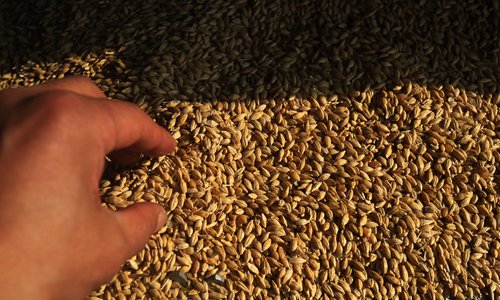HOME >> BUSINESS
China's customs approves Russian barley imports
By Yang Kunyi Source:Global Times Published: 2019/8/1 20:38:41
Move deepens bilateral ties in agricultural collaboration

File photo: IC
Beijing has approved Russian barley to enter the Chinese market, the Chinese customs office said on Thursday. This new approval, which comes several days after the approval of wheat and soybean imports, shows closer collaboration in the agricultural sector between the two countries amid a bruising China-US trade war, experts said.
According to a statement published by the General Administration of Customs (GAC) on Thursday, the barley allowed to be imported to China is grown in seven regions in Russia that are not considered to have risks involving a plant disease called dwarf bunt (Tilletia controversa). The barley imported will only be used for processing instead of planting.
Li Guoxiang, a research fellow at the Rural Development Institute of the Chinese Academy of Social Sciences, told the Global Times on Thursday that barley is barely produced in China, and domestic demand is usually met by imports.
"Barley is most used to brew beers, and making feeds for livestock," Li said, "Before Russia, the main sources of barley imports were Australia and France."
Sun Zhuangzhi, director of the Institute of Russia, Eastern Europe and Central Asia Studies at the Chinese Academy of Social Sciences, told the Global Times that deepening agricultural ties can meet increasing demand in China and provide a large market for Russian exports.
"In the current international environment where US-China trade in agriculture is unstable and Russia's exports are restrained by US sanctions, there is huge room for agricultural collaboration" between China and Russia, Sun said.
On July 26, China approved wheat imports from the Russian region of Kurgan, as well as soybean imports from all parts of Russia, according to statements from the GAC. On Thursday, the Ministry of Commerce confirmed that Chinese companies imported 4,400 tons of Russian soybeans by sea in July.
In 2018, agricultural trade between China and Russia reached 5 billion yuan ($725 million), up 28.2 percent year-on-year. In the first five months of this year, such trade reached $2.2 billion, increasing 1.9 percent year-on-year, according to the GAC.
China and Russia have been strengthening ties in agricultural trade. On June 5, they agreed to upgrade their relationship to a comprehensive strategic partnership of coordination for the new era, which means boosting cooperation in various sectors including agriculture.
However, trade can be expanded by establishing a more comprehensive industrial chain that involves collaboration and agricultural technology transfers. Russia is looking to increase the trade in agricultural trade to 50 billion yuan ($7.25 billion) from 5 billion yuan in the next few years, according to Sun.
Current Russian agricultural exports to China are mostly primary products such as barley or wheat, but more processed products with higher added value can be included in the trade.
"For example, some of the Russian products are not demanded in China. China and Russia can work on the supply and demand structure and collaborate on the logistics, transportation and technology of agricultural products," Sun said. "Russia can take advantage of its massive area of farmland to grow not just wheat and barley, but also other products that are in demand in the Chinese market."
Posted in: INDUSTRIES,BIZ FOCUS